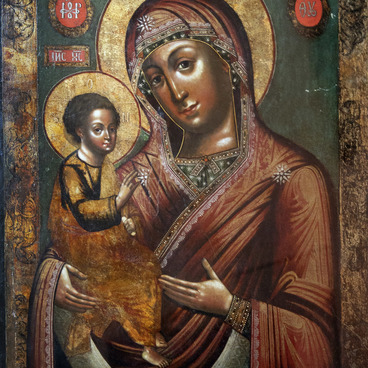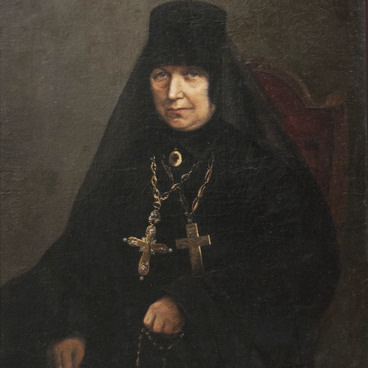The Transfiguration Cathedral Church is the main church of Tambov. There rest the relics of St. Pitirim of Tambov.
In 1636, on the bank of the Tsna River, Voivode Boborykin founded the fortified town of Tambov in order to protect the southern borders of the state from the Crimean Tatars. Together with the town walls, they began to erect a church. The wooden two-storey building was built in three months. The first dean was Moky Pozdnyakov — he consecrated the new church on the feast of the Transfiguration of the Lord.
In 1694, Pitirim, the second bishop of Tambov, began to build a stone cathedral next to the dilapidated wooden one. At first, they
In 1929, the new government banned worship in the cathedral. Three years later, all cathedral murals were painted over, the crosses were removed from the domes, and the building itself was given to the Tambov Ethnography Museum. The relics of St. Pitirim were uncovered and hidden in museum vaults. With the chip stone from the destroyed bell tower, the new government filled up pits and potholes on city roads.
The museum had been located in the cathedral building until 1994. When the cathedral was handed over to the Tambov diocese, restoration work began. The masters restored the frescoes, re-made and installed the iconostasis. By 2012, the bell tower had been built according to old photographs and measurements, and in 2014, the restoration of the Transfiguration Cathedral Church was finally completed.
The photograph of the Transfiguration Cathedral Church was taken in 1904 by Samotsvetov — one of the members of the Tambov Governorate Scientific Archival Commission. This organization was engaged in local history scientific work, research and storage of governorate archives. At the time the picture was taken, Samotsvetov was part of a subcommission that was looking for urban monuments, icons and murals that needed restoration.
In 1636, on the bank of the Tsna River, Voivode Boborykin founded the fortified town of Tambov in order to protect the southern borders of the state from the Crimean Tatars. Together with the town walls, they began to erect a church. The wooden two-storey building was built in three months. The first dean was Moky Pozdnyakov — he consecrated the new church on the feast of the Transfiguration of the Lord.
In 1694, Pitirim, the second bishop of Tambov, began to build a stone cathedral next to the dilapidated wooden one. At first, they
planned to make it one-storey, but the plans changed in the process. The builders erected vaults above the altar and staircases to the second storey. When the walls were ready, Pitirim consecrated one of the aisles of the cathedral and held divine services in it. After the hierarch’s death, the work stopped for several decades, but by 1783 the building had been completed with the money of the Tambov merchant Matvey Borodin.
By the 1810s, the wooden bell tower had become unusable, and they began to build a new, stone and three-storey one near the church. According to some sources, it was completed in 1817, according to others — in the March of 1812. Citizens perceived the new bell tower as a monument to those killed in the Patriotic War against Napoleon. At the end of the 19th century, the north and south wings of the cathedral were completed. By July 1914, they had been plastered the temple, plugged up the holes and cracks in the walls, and painted them with scenes from the life of St. Pitirim. The renewed cathedral welcomed thousands of pilgrims from all over Russia, celebrating Pitirim’s canonisation.
By the 1810s, the wooden bell tower had become unusable, and they began to build a new, stone and three-storey one near the church. According to some sources, it was completed in 1817, according to others — in the March of 1812. Citizens perceived the new bell tower as a monument to those killed in the Patriotic War against Napoleon. At the end of the 19th century, the north and south wings of the cathedral were completed. By July 1914, they had been plastered the temple, plugged up the holes and cracks in the walls, and painted them with scenes from the life of St. Pitirim. The renewed cathedral welcomed thousands of pilgrims from all over Russia, celebrating Pitirim’s canonisation.
In 1929, the new government banned worship in the cathedral. Three years later, all cathedral murals were painted over, the crosses were removed from the domes, and the building itself was given to the Tambov Ethnography Museum. The relics of St. Pitirim were uncovered and hidden in museum vaults. With the chip stone from the destroyed bell tower, the new government filled up pits and potholes on city roads.
The museum had been located in the cathedral building until 1994. When the cathedral was handed over to the Tambov diocese, restoration work began. The masters restored the frescoes, re-made and installed the iconostasis. By 2012, the bell tower had been built according to old photographs and measurements, and in 2014, the restoration of the Transfiguration Cathedral Church was finally completed.
The photograph of the Transfiguration Cathedral Church was taken in 1904 by Samotsvetov — one of the members of the Tambov Governorate Scientific Archival Commission. This organization was engaged in local history scientific work, research and storage of governorate archives. At the time the picture was taken, Samotsvetov was part of a subcommission that was looking for urban monuments, icons and murals that needed restoration.




